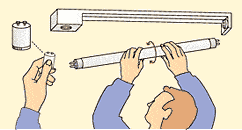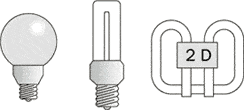Lightning fixtures and lamps
Changing the lamps and the starters of the lighting fixtures in the flat is the tenant’s responsibility, and so is the changing of the oven and refrigerator lamps. If you do not know how to change the lamp of your lighting fixture, ask your roommates or maintenance. Do not try to open a difficult lighting fixture by force. A misused or broken lighting fixture is dangerous.
Changing lamps
Before you start changing a lamp, switch off the current. To switch the current off a lighting fixture equipped with a wall plug, pull the plug out of the socket. To reliably switch the current off a roof or wall lamp, use the main switch or remove the fuse of the lighting set in question. When you change a lamp, it is a good idea to clean the lighting fixture at the same time.
Changing an incandescent bulb
 Switch off the current and let the bulb cool down. Unscrew the burnt bulb carefully, or else it may come off its cap. Screw in a new bulb. The power of the new bulb must not exceed the power marking in the lighting fixture (e.g. 60 W). Please remember that you can install a head reflector bulb only into lighting fixtures marked with the symbol . Installing a head reflector bulb or a bulb with too high a power rating into a wrong lighting fixture may cause overheating, which creates a fire hazard. You can recognize a head reflector bulb from the metal coating on its dome. The metal coating reflects most of the heat produced by the bulb back to the lighting fixture, thus heating the fixture more than an ordinary incandescent bulb. If you replace your incandescent lamps with energy-saving lamps, you get a whole lot more light with less power. For example, a 15 W energy-saving lamp will give you considerably more light for less power than a 60 W incandescent lamp.
Switch off the current and let the bulb cool down. Unscrew the burnt bulb carefully, or else it may come off its cap. Screw in a new bulb. The power of the new bulb must not exceed the power marking in the lighting fixture (e.g. 60 W). Please remember that you can install a head reflector bulb only into lighting fixtures marked with the symbol . Installing a head reflector bulb or a bulb with too high a power rating into a wrong lighting fixture may cause overheating, which creates a fire hazard. You can recognize a head reflector bulb from the metal coating on its dome. The metal coating reflects most of the heat produced by the bulb back to the lighting fixture, thus heating the fixture more than an ordinary incandescent bulb. If you replace your incandescent lamps with energy-saving lamps, you get a whole lot more light with less power. For example, a 15 W energy-saving lamp will give you considerably more light for less power than a 60 W incandescent lamp.
Changing a fluorescent lamp and starter
 Switch off the current before starting the work. A fluorescent lamp is usually removed from the lighting fixture by turning it one quarter of a turn. The lamp comes out by sliding the pins at its both ends out of their holders. Replace the lamp with a new one of the same power rating and a suitable colour shade. Many fluorescent lamp fixtures have a starter, and that should be changed when the lamp is changed. Electronic starters and tunable starters with manual push-button control are an exception. To change a starter, turn it counter-clockwise so that its pins are freed through the gap in the starter holder. Then put in the new starter.
Switch off the current before starting the work. A fluorescent lamp is usually removed from the lighting fixture by turning it one quarter of a turn. The lamp comes out by sliding the pins at its both ends out of their holders. Replace the lamp with a new one of the same power rating and a suitable colour shade. Many fluorescent lamp fixtures have a starter, and that should be changed when the lamp is changed. Electronic starters and tunable starters with manual push-button control are an exception. To change a starter, turn it counter-clockwise so that its pins are freed through the gap in the starter holder. Then put in the new starter.
Changing a miniature fluorescent lamp
 Switch off the current before starting the work. There are different types of miniature fluorescent lamps, but they all work in the same way as ordinary fluorescent lamps and consume less energy than incandescent lamps. The miniature fluorescent lamps which are probably the most common ones in households are shown in the picture. To change a lamp, pull it out of its socket (see the picture). A new lamp is installed by pushing its cap into the lamp socket. Replace a lamp with one having the same power rating. Miniature fluorescent lamps usually have a built-in starter, so that you need not change the starter separately. A miniature fluorescent lamp with a screw cap is changed in the same way as an incandescent lamp.
Switch off the current before starting the work. There are different types of miniature fluorescent lamps, but they all work in the same way as ordinary fluorescent lamps and consume less energy than incandescent lamps. The miniature fluorescent lamps which are probably the most common ones in households are shown in the picture. To change a lamp, pull it out of its socket (see the picture). A new lamp is installed by pushing its cap into the lamp socket. Replace a lamp with one having the same power rating. Miniature fluorescent lamps usually have a built-in starter, so that you need not change the starter separately. A miniature fluorescent lamp with a screw cap is changed in the same way as an incandescent lamp.
Changing a halogen lamp
Switch off the current and let the lamp cool down before the change. You should not touch the new bulb with bare fingers, for the grease secreted by your skin would burn into its surface and shorten its life. Replace a halogen lamp with one of similar voltage, power, and structure.


